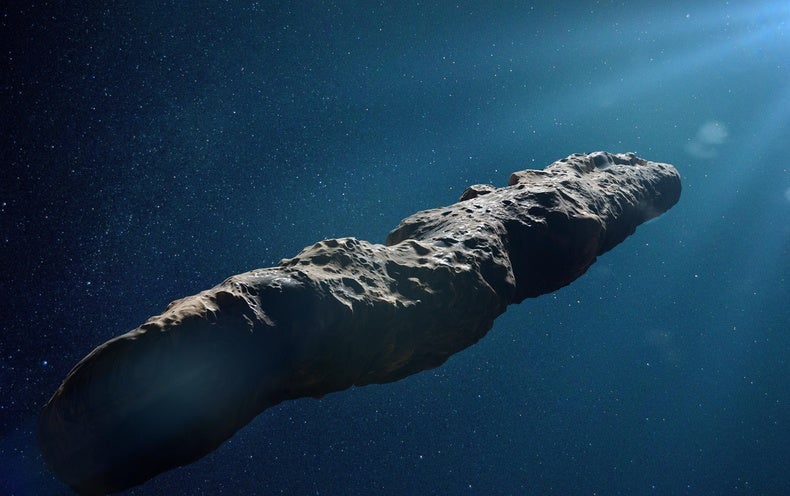Scientists have a new idea to explain the strange behavior of ‘Oumuamua, our solar system’s first known interstellar visitor.
In October 2017 astronomers first spotted the object by chance as it passed through the inner solar system on a slingshot trajectory around the sun that would send it soaring back out to interstellar space. The brief flyby offered only a few weeks for researchers to study ‘Oumuamua before it faded forever from view, leaving behind more questions than answers. Even now, more than five years after the object’s discovery, researchers are still struggling to make sense of the precious few observations they managed to obtain—especially those that revealed ‘Oumuamua moving more quickly away from the sun than gravity alone could explain. Against all expectations, the object had somehow “hit the gas” as it departed, like a spooked driver speeding away from a seedy part of town.
Now, in a paper published on March 22 in Nature, two researchers say ‘Oumuamua’s unexpected acceleration may have been caused by hitting the gas after all—specifically, from the propulsive effect of hydrogen gas billowing from the sun-warmed object’s presumptive surface of water ice. If true, the hypothesis would strengthen the case that ‘Oumuamua was not some extremely odd one-of-a-kind object (or even a derelict alien spacecraft) but rather a natural cometlike body.
“This scenario just seemed like it would allow us to start with something that looked more normal, like a solar system comet, and still have the sort of end phenomenon of explaining this nongravitational acceleration,” says Jennifer Bergner, a chemist at the University of California, Berkeley, and lead author of the new research.
This study offers a new twist on previous ideas that suggested ‘Oumuamua might have been a volatile, plume-spewing chunk of solid hydrogen or nitrogen—materials that are less sturdy than water ice. Many experts remain skeptical that such a fragile object could survive the hazardous journey through the solar system, let alone form in the first place. And astronomers say that, given irreducible gaps in our knowledge of ‘Oumuamua, this new proposal may never be fully accepted either. “It’s a nice idea; I just don’t know if it can ever be proved,” says Karen Meech, an astronomer at the University of Hawaii, who was not involved in the new research.
In the new paper, Bergner and her coauthor Darryl Seligman, an astrophysicist who cowrote a 2020 paper positing the hydrogen ice hypothesis, propose that the interloper formed in another planetary system as a run-of-the-mill comet composed mostly of resilient water ice, quite like those in our own stellar neighborhood. A too-close encounter with a planet or star in the alien system could have then flung the object out into interstellar space—and on its way to us.
And indeed, our solar system’s comets are rich in water ice and are regularly kicked around by larger objects. And when bathed in sunlight, they display plenty of nongravitational acceleration, notes Jane Luu, an astronomer at Tufts University, who was not involved in the new research. “Comets do it all the time,” Luu says of this acceleration. “They’re like rockets, right? They outgas, and when they spit something out, Newton’s law says you go the other way.”
But previous work has shown that sublimating water ice alone couldn’t provide enough push to explain ‘Oumuamua’s anomalous acceleration, so the authors of the new paper add an additional step. As the object traveled through interstellar space, they write, energetic cosmic rays battered its surface and broke apart some of its water ice to form hydrogen. Rather than escaping to space, most of the hydrogen remained locked within the surrounding ice. But as ‘Oumuamua approached our star, sunlight warmed and released the trapped hydrogen from its water-ice cage to create the extra acceleration.
This theory could address a key piece of ‘Oumuamua’s puzzle. An outgassing comet should be enveloped by a distinctive feature called a coma, a bright-but-fuzzy halo of light-scattering dust carried away by the outgassing. Yet observers never saw a coma around ‘Oumuamua—a key conundrum in explaining its acceleration.
“We have never, ever seen ice outgassing without dust. Never,” Luu says. “Dust and ice usually go together.”
But according to Bergner and Seligman’s work, ‘Oumuamua’s dust could have remained trapped within the ice even as hydrogen escaped. “Overall, the matrix should still be intact,” Bergner says. “And so we think it’s possible that the dust still remains sort of embedded in the water ice.”
The paper doesn’t make sense of ‘Oumuamua’s strange, shardlike shape, however, Meech notes. “This is a nice model, but it certainly does not explain everything,” she says. Bergner agrees that the new research doesn’t directly address the object’s shape but notes that Seligman’s previous research showed that round or disk-shaped hydrogen icebergs, should any exist, could be weathered by cosmic rays into oblong shapes.
Bergner hopes scientists will eventually see a phenomenon similar to the paper’s scenario among our own solar system’s comets, if astronomers can watch a roughly ‘Oumuamua-sized one making its first inward journey from reservoirs in the outer solar system. Although such comets wouldn’t be interstellar émigrés, in the solar system’s hinterlands, they should still receive sufficient cosmic radiation for hydrogen gas to accumulate within their water ice, Bergner says. The trick will be finding them. Astronomers have never seen a native comet as small as ‘Oumuamua, although that may change with the Vera C. Rubin Observatory, which is due to begin a massive survey in early 2025.
As for ‘Oumuamua itself, Meech, Luu and Bergner all agree that frustratingly, with the icy interloper long gone, there’s really no way to test the claims offered by this (or any other) new research. “At this point, you can say anything you want about this object because it will never, ever, ever be seen again,” Luu says.

